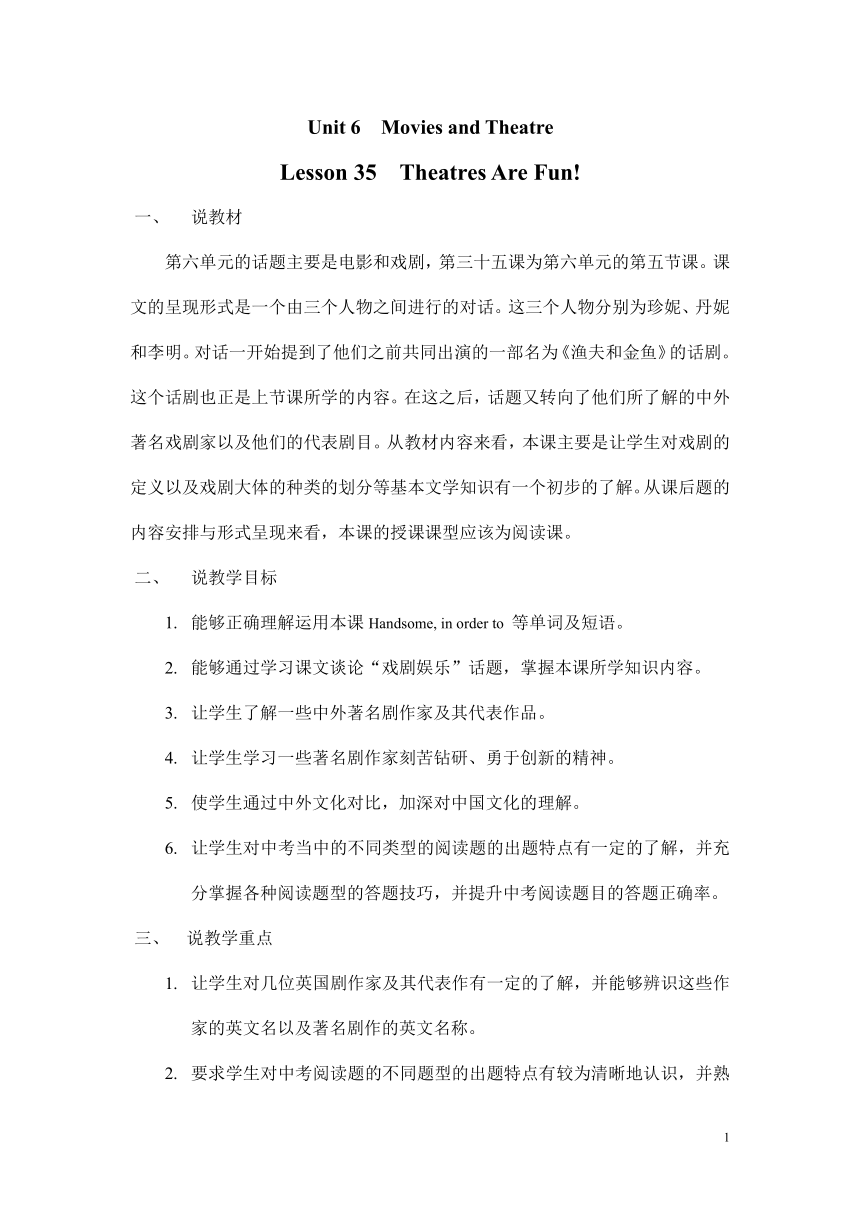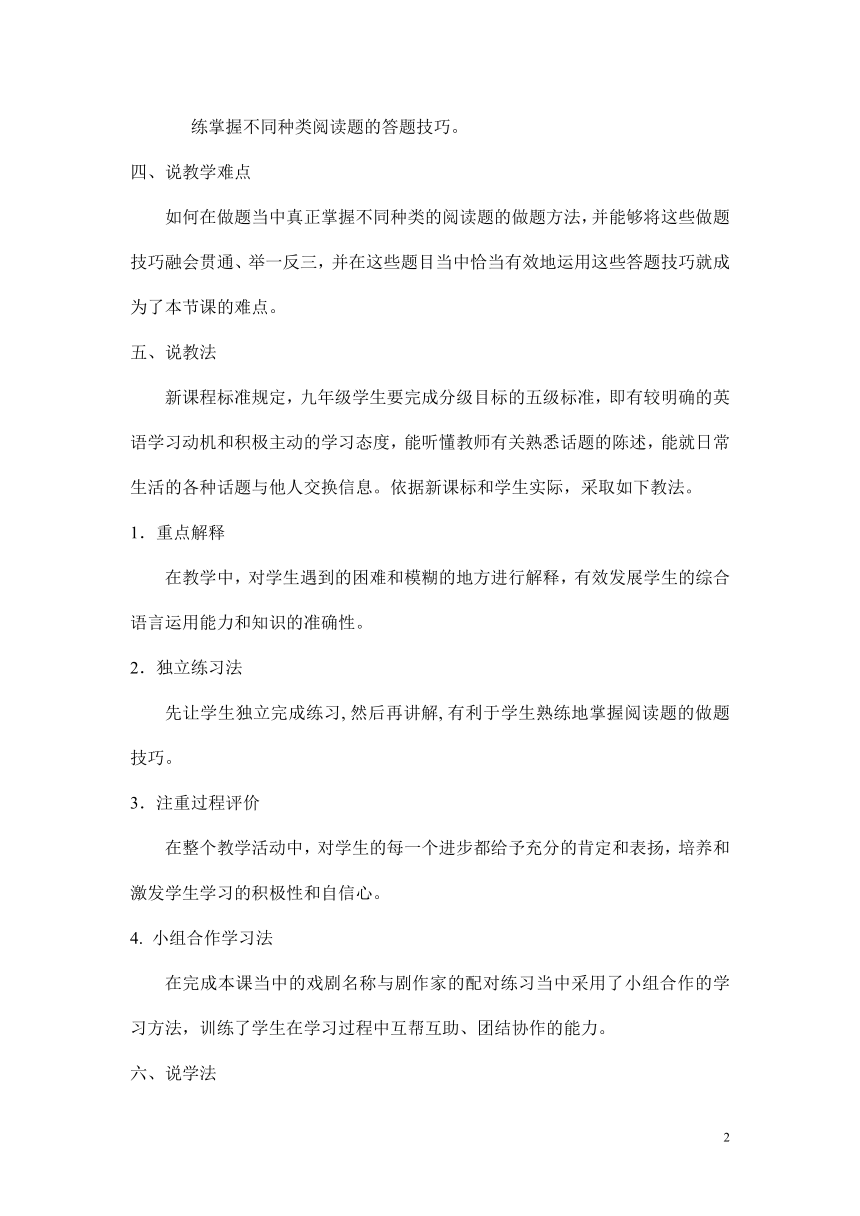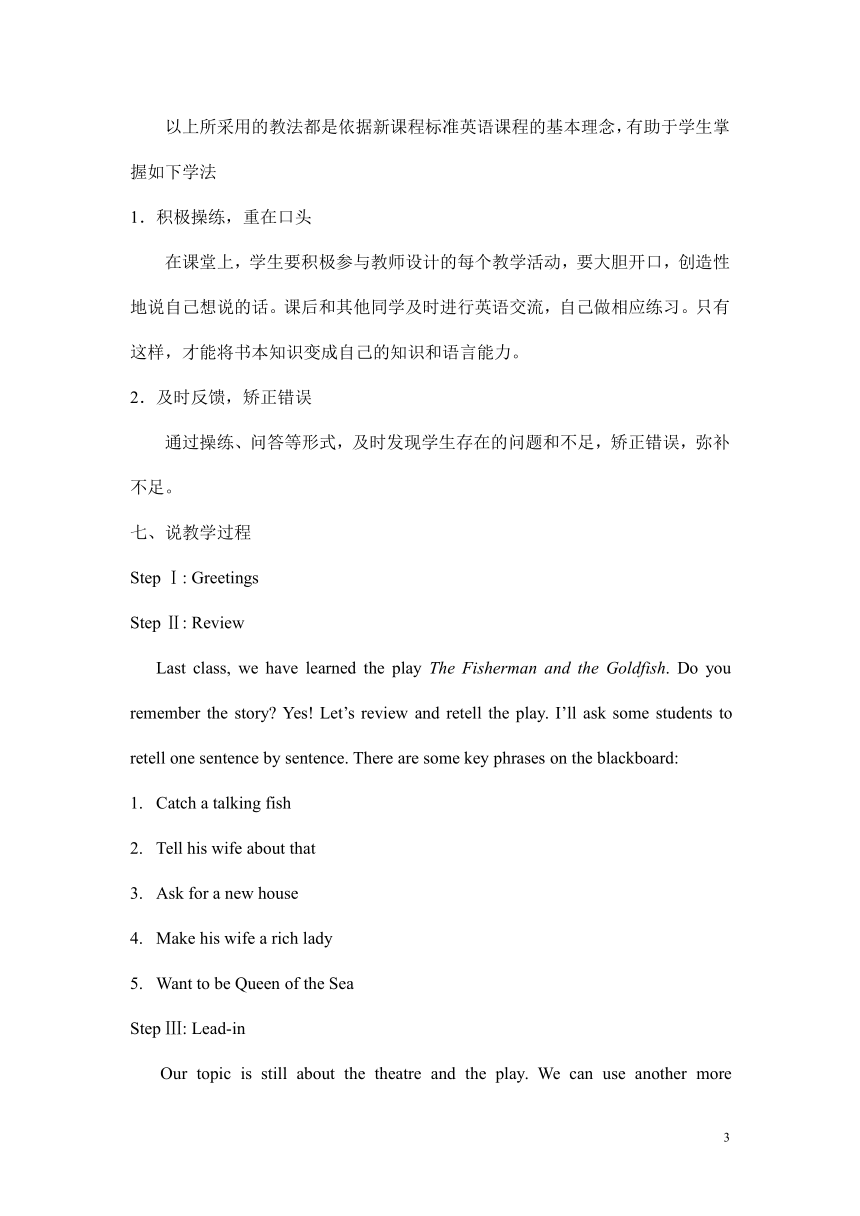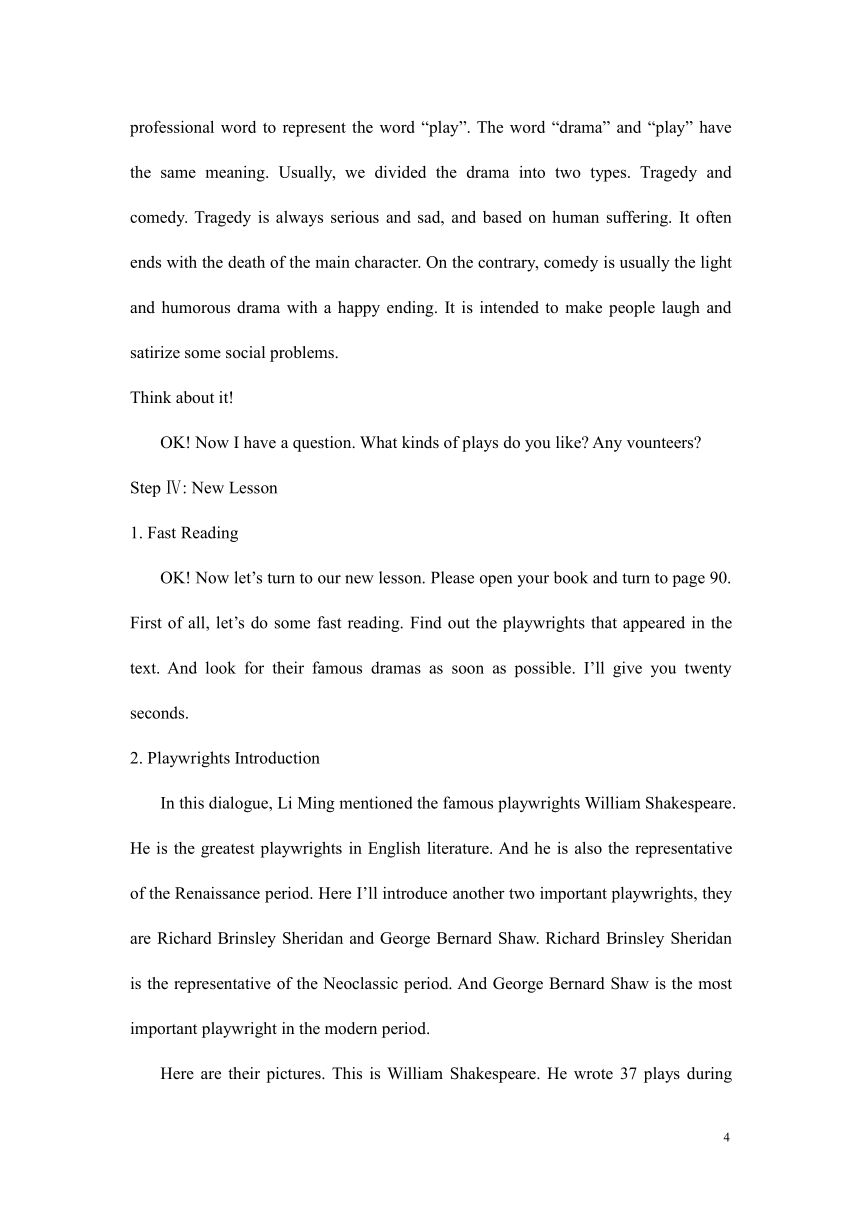冀教版英语九年级上Unit 6 Movies and TheaterLesson 35 Theatres Are Fun!说课稿(1课时)
文档属性
| 名称 | 冀教版英语九年级上Unit 6 Movies and TheaterLesson 35 Theatres Are Fun!说课稿(1课时) |

|
|
| 格式 | zip | ||
| 文件大小 | 13.8KB | ||
| 资源类型 | 教案 | ||
| 版本资源 | 冀教版 | ||
| 科目 | 英语 | ||
| 更新时间 | 2020-05-07 22:58:52 | ||
图片预览




文档简介
Unit 6 Movies and Theatre
Lesson 35 Theatres Are Fun!
说教材
第六单元的话题主要是电影和戏剧,第三十五课为第六单元的第五节课。课文的呈现形式是一个由三个人物之间进行的对话。这三个人物分别为珍妮、丹妮和李明。对话一开始提到了他们之前共同出演的一部名为《渔夫和金鱼》的话剧。这个话剧也正是上节课所学的内容。在这之后,话题又转向了他们所了解的中外著名戏剧家以及他们的代表剧目。从教材内容来看,本课主要是让学生对戏剧的定义以及戏剧大体的种类的划分等基本文学知识有一个初步的了解。从课后题的内容安排与形式呈现来看,本课的授课课型应该为阅读课。
说教学目标
能够正确理解运用本课Handsome, in order to 等单词及短语。
能够通过学习课文谈论“戏剧娱乐”话题,掌握本课所学知识内容。
让学生了解一些中外著名剧作家及其代表作品。
让学生学习一些著名剧作家刻苦钻研、勇于创新的精神。
使学生通过中外文化对比,加深对中国文化的理解。
让学生对中考当中的不同类型的阅读题的出题特点有一定的了解,并充分掌握各种阅读题型的答题技巧,并提升中考阅读题目的答题正确率。
三、 说教学重点
让学生对几位英国剧作家及其代表作有一定的了解,并能够辨识这些作家的英文名以及著名剧作的英文名称。
要求学生对中考阅读题的不同题型的出题特点有较为清晰地认识,并熟练掌握不同种类阅读题的答题技巧。
四、说教学难点?
如何在做题当中真正掌握不同种类的阅读题的做题方法,并能够将这些做题技巧融会贯通、举一反三,并在这些题目当中恰当有效地运用这些答题技巧就成为了本节课的难点。 五、说教法 新课程标准规定,九年级学生要完成分级目标的五级标准,即有较明确的英语学习动机和积极主动的学习态度,能听懂教师有关熟悉话题的陈述,能就日常生活的各种话题与他人交换信息。依据新课标和学生实际,采取如下教法。 1.重点解释 在教学中,对学生遇到的困难和模糊的地方进行解释,有效发展学生的综合语言运用能力和知识的准确性。 2.独立练习法 先让学生独立完成练习,?然后再讲解,?有利于学生熟练地掌握阅读题的做题技巧。 3.注重过程评价 在整个教学活动中,对学生的每一个进步都给予充分的肯定和表扬,培养和激发学生学习的积极性和自信心。
4. 小组合作学习法
在完成本课当中的戏剧名称与剧作家的配对练习当中采用了小组合作的学习方法,训练了学生在学习过程中互帮互助、团结协作的能力。 六、说学法 以上所采用的教法都是依据新课程标准英语课程的基本理念,有助于学生掌握如下学法 1.积极操练,重在口头? 在课堂上,学生要积极参与教师设计的每个教学活动,要大胆开口,创造性地说自己想说的话。课后和其他同学及时进行英语交流,自己做相应练习。只有这样,才能将书本知识变成自己的知识和语言能力。 2.及时反馈,矫正错误 通过操练、问答等形式,及时发现学生存在的问题和不足,矫正错误,弥补不足。 七、说教学过程 Step Ⅰ: Greetings
Step Ⅱ: Review
Last class, we have learned the play The Fisherman and the Goldfish. Do you remember the story? Yes! Let’s review and retell the play. I’ll ask some students to retell one sentence by sentence. There are some key phrases on the blackboard:
Catch a talking fish
Tell his wife about that
Ask for a new house
Make his wife a rich lady
Want to be Queen of the Sea
Step Ⅲ: Lead-in
Our topic is still about the theatre and the play. We can use another more professional word to represent the word “play”. The word “drama” and “play” have the same meaning. Usually, we divided the drama into two types. Tragedy and comedy. Tragedy is always serious and sad, and based on human suffering. It often ends with the death of the main character. On the contrary, comedy is usually the light and humorous drama with a happy ending. It is intended to make people laugh and satirize some social problems.
Think about it!
OK! Now I have a question. What kinds of plays do you like? Any vounteers?
Step Ⅳ: New Lesson
1. Fast Reading
OK! Now let’s turn to our new lesson. Please open your book and turn to page 90. First of all, let’s do some fast reading. Find out the playwrights that appeared in the text. And look for their famous dramas as soon as possible. I’ll give you twenty seconds.
2. Playwrights Introduction
In this dialogue, Li Ming mentioned the famous playwrights William Shakespeare. He is the greatest playwrights in English literature. And he is also the representative of the Renaissance period. Here I’ll introduce another two important playwrights, they are Richard Brinsley Sheridan and George Bernard Shaw. Richard Brinsley Sheridan is the representative of the Neoclassic period. And George Bernard Shaw is the most important playwright in the modern period.
Here are their pictures. This is William Shakespeare. He wrote 37 plays during his life. The most famous plays are his four tragedies and the four comedies. The four tragedies include Hamlet, King Lear, Othello and Macbeth. And the four comedies are The Merchant of Venice, A Midsummer Night’s Dream, As You Like It and Twelfth Night.
Every drama has its theme. The theme of Hamlet is revenge and Weakness of human nature:hesitation. King Lear is a play about the power and the desire. The theme of Othello is about the doubt and envy in human nature. Macbeth tells us a story about the ambition, fear and suspicion. William Shakespeare praised the friendship and love and satirized greed in the comedy, the Merchant of the Venice. A Midsummer Night’s Dream is a play about the misfit. The theme of As You Like It is that kindness could defeat evil. In the comedy, Twelfth Night, William Shakespeare praised women’s talent and advocated equality between men and women.
This is Richard Brinsley Sheridan. The School for Scandal is his most famous comedy. He Satirized the immorality and hypocrisy of the upper class.
George Bernard Shaw wrote a lot of plays about the social problem. The three plays, Mrs. Warren’s Profession, Pygmalion and Widowers’ Houses are all his famous plays.
In this dialogue, they also mentioned Lao She and Cao Yu. Lao She is well-known for his famous plays, Teahouse and Longxu Slum. Sunrise and Thunderstorm are Cao Yu’s representative works.
3. Matching Game
Now we have learned many famous playwrights and their drama. Then, let’s do a matching game. There is a big poster on your desk for each group. There are also sixteen plays. Match each play with its playwright. This is a team work. You should cooperate with each other.
4. Reading Comprehension
Now let’s do some reading comprehension. There are four kinds of question. They are detail questions, main idea questions, word guessing questions and reference questions.
The first type is the detail questions. For detail questions, we can find out the answer directly in the passage. The most important thing is looking for the source of information. In order to find out the source of information, location words can be very helpful. Pay attention to these types of words. Because these words can be easily found in the passage, they can lead us to find the source of information as soon as possible.
There are six detail questions, try to find the source of information within one minute.
(1)William Shakespeare is a world-famous playwright.
(2)Shakespeare’s works are all comedies and historical pieces.
(3)Hamlet is a famous comedy.
(4)Teahouse was written by Lao She.
(5)Cao Yu wrote the play Thunderstorm.
(6)In Lao She Teahouse Theatre, you can drink tea while enjoying a play.
The second type is the main idea question. When you did this type of questions, you should pay attention to the first paragraph and the last paragraph of the passage. At the same time, you need to focus on the repeated content of the passage. The topic sentence of each paragraph should also be noticed.
This is a main idea question. Who wants to try?
The dialogue among Jenny, Danny and Li Ming are mainly about ________ .
A.fiction B.drama
C.poem D.playwrights and drama
The third type is Word Guessing question. In order to deal with this kind of questions, first you should accumulate new words and phrases everyday. Then making use of the context is very help. Sometimes, you can also judge the structural relation in a word.
Look at the two questions. Who can answer them?
(1) What does the word “handsome” mean in this dialogue? ________ .
A.可观的 B. 慷慨的
C.英俊的 D. 相当大的
(2) What does the word “works” (the fourteenth line) mean in this dialogue? ________ .
A.工作 B. 作品
C.作业 D. 工厂
The last type is the reference questions. This kind question is the most difficult. we cannot find out the answer directly in the passage. We can Judge from the given information. We should use the exclusive method to do with this kind of questions. Sometimes, the complex reasoning is also needed.
Let’s look at the two questions.
(1) From the dialogue we can learn that ________ .
A.Danny might become a good actor in the future.
B.Li Ming knew nothing about foreign playwrights and dramas.
C.Danny might like the Lao She Teahouse in Beijing.
D.Jenny and Danny have never been to the Lao She Teahouse in Beijing.
(2) Jenny probably agrees that________ .
A.every member in her team worked very hard to make this play.
B. Danny is a very good and handsome actor.
C. the Lao She Teahouse in Beijing is an ordinary tea house.
D. most of William Shakespeare’s early plays are tragedies.
Step Ⅴ: Exercise
Reading comprehension: A, B, C&D. (P110-113)
Step Ⅵ: Homework
1. Complete Let’s Do It! No. 3.
2. Finish off the exercises in the activity book.
3. Preview Lesson 36.
Lesson 35 Theatres Are Fun!
说教材
第六单元的话题主要是电影和戏剧,第三十五课为第六单元的第五节课。课文的呈现形式是一个由三个人物之间进行的对话。这三个人物分别为珍妮、丹妮和李明。对话一开始提到了他们之前共同出演的一部名为《渔夫和金鱼》的话剧。这个话剧也正是上节课所学的内容。在这之后,话题又转向了他们所了解的中外著名戏剧家以及他们的代表剧目。从教材内容来看,本课主要是让学生对戏剧的定义以及戏剧大体的种类的划分等基本文学知识有一个初步的了解。从课后题的内容安排与形式呈现来看,本课的授课课型应该为阅读课。
说教学目标
能够正确理解运用本课Handsome, in order to 等单词及短语。
能够通过学习课文谈论“戏剧娱乐”话题,掌握本课所学知识内容。
让学生了解一些中外著名剧作家及其代表作品。
让学生学习一些著名剧作家刻苦钻研、勇于创新的精神。
使学生通过中外文化对比,加深对中国文化的理解。
让学生对中考当中的不同类型的阅读题的出题特点有一定的了解,并充分掌握各种阅读题型的答题技巧,并提升中考阅读题目的答题正确率。
三、 说教学重点
让学生对几位英国剧作家及其代表作有一定的了解,并能够辨识这些作家的英文名以及著名剧作的英文名称。
要求学生对中考阅读题的不同题型的出题特点有较为清晰地认识,并熟练掌握不同种类阅读题的答题技巧。
四、说教学难点?
如何在做题当中真正掌握不同种类的阅读题的做题方法,并能够将这些做题技巧融会贯通、举一反三,并在这些题目当中恰当有效地运用这些答题技巧就成为了本节课的难点。 五、说教法 新课程标准规定,九年级学生要完成分级目标的五级标准,即有较明确的英语学习动机和积极主动的学习态度,能听懂教师有关熟悉话题的陈述,能就日常生活的各种话题与他人交换信息。依据新课标和学生实际,采取如下教法。 1.重点解释 在教学中,对学生遇到的困难和模糊的地方进行解释,有效发展学生的综合语言运用能力和知识的准确性。 2.独立练习法 先让学生独立完成练习,?然后再讲解,?有利于学生熟练地掌握阅读题的做题技巧。 3.注重过程评价 在整个教学活动中,对学生的每一个进步都给予充分的肯定和表扬,培养和激发学生学习的积极性和自信心。
4. 小组合作学习法
在完成本课当中的戏剧名称与剧作家的配对练习当中采用了小组合作的学习方法,训练了学生在学习过程中互帮互助、团结协作的能力。 六、说学法 以上所采用的教法都是依据新课程标准英语课程的基本理念,有助于学生掌握如下学法 1.积极操练,重在口头? 在课堂上,学生要积极参与教师设计的每个教学活动,要大胆开口,创造性地说自己想说的话。课后和其他同学及时进行英语交流,自己做相应练习。只有这样,才能将书本知识变成自己的知识和语言能力。 2.及时反馈,矫正错误 通过操练、问答等形式,及时发现学生存在的问题和不足,矫正错误,弥补不足。 七、说教学过程 Step Ⅰ: Greetings
Step Ⅱ: Review
Last class, we have learned the play The Fisherman and the Goldfish. Do you remember the story? Yes! Let’s review and retell the play. I’ll ask some students to retell one sentence by sentence. There are some key phrases on the blackboard:
Catch a talking fish
Tell his wife about that
Ask for a new house
Make his wife a rich lady
Want to be Queen of the Sea
Step Ⅲ: Lead-in
Our topic is still about the theatre and the play. We can use another more professional word to represent the word “play”. The word “drama” and “play” have the same meaning. Usually, we divided the drama into two types. Tragedy and comedy. Tragedy is always serious and sad, and based on human suffering. It often ends with the death of the main character. On the contrary, comedy is usually the light and humorous drama with a happy ending. It is intended to make people laugh and satirize some social problems.
Think about it!
OK! Now I have a question. What kinds of plays do you like? Any vounteers?
Step Ⅳ: New Lesson
1. Fast Reading
OK! Now let’s turn to our new lesson. Please open your book and turn to page 90. First of all, let’s do some fast reading. Find out the playwrights that appeared in the text. And look for their famous dramas as soon as possible. I’ll give you twenty seconds.
2. Playwrights Introduction
In this dialogue, Li Ming mentioned the famous playwrights William Shakespeare. He is the greatest playwrights in English literature. And he is also the representative of the Renaissance period. Here I’ll introduce another two important playwrights, they are Richard Brinsley Sheridan and George Bernard Shaw. Richard Brinsley Sheridan is the representative of the Neoclassic period. And George Bernard Shaw is the most important playwright in the modern period.
Here are their pictures. This is William Shakespeare. He wrote 37 plays during his life. The most famous plays are his four tragedies and the four comedies. The four tragedies include Hamlet, King Lear, Othello and Macbeth. And the four comedies are The Merchant of Venice, A Midsummer Night’s Dream, As You Like It and Twelfth Night.
Every drama has its theme. The theme of Hamlet is revenge and Weakness of human nature:hesitation. King Lear is a play about the power and the desire. The theme of Othello is about the doubt and envy in human nature. Macbeth tells us a story about the ambition, fear and suspicion. William Shakespeare praised the friendship and love and satirized greed in the comedy, the Merchant of the Venice. A Midsummer Night’s Dream is a play about the misfit. The theme of As You Like It is that kindness could defeat evil. In the comedy, Twelfth Night, William Shakespeare praised women’s talent and advocated equality between men and women.
This is Richard Brinsley Sheridan. The School for Scandal is his most famous comedy. He Satirized the immorality and hypocrisy of the upper class.
George Bernard Shaw wrote a lot of plays about the social problem. The three plays, Mrs. Warren’s Profession, Pygmalion and Widowers’ Houses are all his famous plays.
In this dialogue, they also mentioned Lao She and Cao Yu. Lao She is well-known for his famous plays, Teahouse and Longxu Slum. Sunrise and Thunderstorm are Cao Yu’s representative works.
3. Matching Game
Now we have learned many famous playwrights and their drama. Then, let’s do a matching game. There is a big poster on your desk for each group. There are also sixteen plays. Match each play with its playwright. This is a team work. You should cooperate with each other.
4. Reading Comprehension
Now let’s do some reading comprehension. There are four kinds of question. They are detail questions, main idea questions, word guessing questions and reference questions.
The first type is the detail questions. For detail questions, we can find out the answer directly in the passage. The most important thing is looking for the source of information. In order to find out the source of information, location words can be very helpful. Pay attention to these types of words. Because these words can be easily found in the passage, they can lead us to find the source of information as soon as possible.
There are six detail questions, try to find the source of information within one minute.
(1)William Shakespeare is a world-famous playwright.
(2)Shakespeare’s works are all comedies and historical pieces.
(3)Hamlet is a famous comedy.
(4)Teahouse was written by Lao She.
(5)Cao Yu wrote the play Thunderstorm.
(6)In Lao She Teahouse Theatre, you can drink tea while enjoying a play.
The second type is the main idea question. When you did this type of questions, you should pay attention to the first paragraph and the last paragraph of the passage. At the same time, you need to focus on the repeated content of the passage. The topic sentence of each paragraph should also be noticed.
This is a main idea question. Who wants to try?
The dialogue among Jenny, Danny and Li Ming are mainly about ________ .
A.fiction B.drama
C.poem D.playwrights and drama
The third type is Word Guessing question. In order to deal with this kind of questions, first you should accumulate new words and phrases everyday. Then making use of the context is very help. Sometimes, you can also judge the structural relation in a word.
Look at the two questions. Who can answer them?
(1) What does the word “handsome” mean in this dialogue? ________ .
A.可观的 B. 慷慨的
C.英俊的 D. 相当大的
(2) What does the word “works” (the fourteenth line) mean in this dialogue? ________ .
A.工作 B. 作品
C.作业 D. 工厂
The last type is the reference questions. This kind question is the most difficult. we cannot find out the answer directly in the passage. We can Judge from the given information. We should use the exclusive method to do with this kind of questions. Sometimes, the complex reasoning is also needed.
Let’s look at the two questions.
(1) From the dialogue we can learn that ________ .
A.Danny might become a good actor in the future.
B.Li Ming knew nothing about foreign playwrights and dramas.
C.Danny might like the Lao She Teahouse in Beijing.
D.Jenny and Danny have never been to the Lao She Teahouse in Beijing.
(2) Jenny probably agrees that________ .
A.every member in her team worked very hard to make this play.
B. Danny is a very good and handsome actor.
C. the Lao She Teahouse in Beijing is an ordinary tea house.
D. most of William Shakespeare’s early plays are tragedies.
Step Ⅴ: Exercise
Reading comprehension: A, B, C&D. (P110-113)
Step Ⅵ: Homework
1. Complete Let’s Do It! No. 3.
2. Finish off the exercises in the activity book.
3. Preview Lesson 36.
同课章节目录
- Unit 1 Stay Healthy
- Lesson 1 What's Wrong,Danny?
- Lesson 2 A Visit to the Dentist
- Lesson 3 Good Food, Good Health
- Lesson 4 Don't Smoke, Please!
- Lesson 5 Jane's Lucky Life
- Lesson 6 Stay Away from the Hospital
- Unit Review
- Unit 2 Great People
- Lesson 7 What Is the Meaning of Lift?
- Lesson 8 A Universe of Thought
- Lesson 9 China's Most Famous "Farmer"
- Lesson 10 Touch the World
- Lesson 11 To China, with Love
- Lesson 12 Guess My Hero!
- Unit Review
- Unit 3 Safety
- Lesson 13 Be Careful,Danny!
- Lesson 14 Accidents Happen
- Lesson 15 My Helmet Saved My Life!
- Lesson 16 How Safe Is Your Home?
- Lesson 17 Staying Safe in an Earthquake
- Lesson 18 Never Catch a Dinosaur
- Unit Review
- Unit 4 Stories and poems
- Lesson 19 A Story or a Poem?
- Lesson 20 Say It in Five
- Lesson 21 The Fable of the Woodcutte
- Lesson 22 The Giant(Ⅰ)
- Lesson 23 The Giant(Ⅱ)
- Lesson 24 Writing a Poem
- Unit Review
- Unit 5 Look into Science
- Lesson 25 Let's Do an Experiment!
- Lesson 26 Keep the Candle Burning
- Lesson 27 Planet Danny
- Lesson 28 The Study of Living Things
- Lesson 29 DNA—The Story of You
- Lesson 30 Science Affects Us
- Unit Review
- Unit 6 Movies and Theate
- Lesson 31 A movie or a Play
- Lesson 32 Moving Pictures
- Lesson 33 The Fisherman and the Goldfish(Ⅰ)
- Lesson 34 The Fisherman and the Goldfish(Ⅱ)
- Lesson 35 Theatres Are Fun!
- Lesson 36 Making Plays Is Fun
- Unit Review
